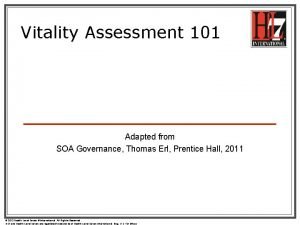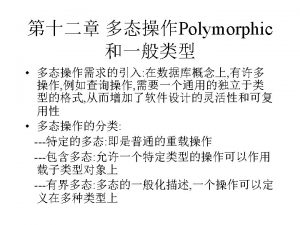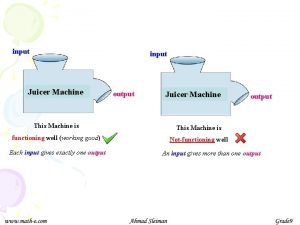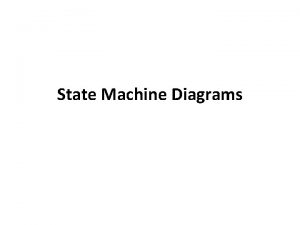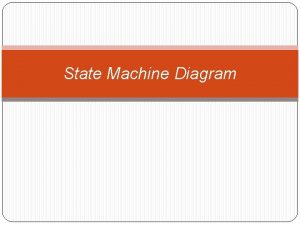The Machine Age and the Vitality and Turmoil

















- Slides: 17

The Machine Age and the Vitality and Turmoil of Urban Life, 1877 -1920

Key Terms Henry Ford Urbanization Assembly Line Mechanization 5 Dollar A Day Plan Craftsmen Scientific Management Frederick W. Tyalor Branding/Advertising Vertical Integration Horizontal Integration Profit Sharing Unions Strikes Immigration

How did Industrialization change America and the lives of Americans? Was this era truly a Gilded Age?

Outline I. Consumption and Production II. Inventors and Businessmen A. Thomas Edison B. Andrew Carnegie III. Henry Ford—A Case Study A. Horizontal Integration B. Vertical Integration C. Branding Marketing D. Financing

IV. Workers A. Loss of Position as Producers B. Become Employees and Consumers C. Scientific Management D. Women E. Children F. Accidents G. Free Labor Contract

Significance Industrialization critical, not only because it transformed the lives of Americans and the relationships between Americans, but because it transformed America’s relationship with the world, leading to its reign as a superpower. Industrialization increased the power of government. It transformed workers’ relationships with their production. It transformed the family and culture by ushering in an age of consumption and leisure. It spawned mass urbanization that created sanitary crises and racial conflicts.

Thomas Edison, 1847 -1931

Andrew Carnegie, 1835 -1919

Henry Ford, c. 1919, b. 1863, d. 1947. “ I am going to democratize the automobile. ”

Henry Ford constantly worked to reduce car prices on his cars. He also promoted installment buying, promising in this ad that "with even the most modest income, [every family] can now afford a car of their own. " This ad also encouraged impulse buying: "You live but once and the years roll by quickly. Why wait for tomorrow for things that you rightfully should enjoy today? "

Elgin National Watch Company The combination of machines and workers still required meticulous hand-work in some industries. Often women with nimble fingers could find jobs in industries such as jewelry and watch-making where, as at this room at the Elgin National Watch Company, they could swiftly manipulate tiny production processes. Chicago Historical Society

Distribution of Occupational Categories Among Employed Men and Women, 1880– 1920 The changing lengths of the bar segments of each part of this graph represent trends in male and female employment. Over the forty years covered by this graph, the agriculture, fishing, and mining segment for men and the domestic service segment for women declined the most, whereas notable increases occurred in manufacturing for men and professional services especially store clerks and teachers for women. U. S. Bureau of the Census, Census of the United States, 1880, 1890, 1900, 1910, 1920 [Washington, D. C. : U. S. Government Printing Office].

Children in the Labor Force, 1880– 1930 The percentage of children in the labor force peaked around the turn of the century. Thereafter, the passage of state laws requiring children to attend school until age fourteen and limiting the ages at which children could be employed caused child labor to decline. Data from The Statistical History of the United States from Colonial Times to the Present [Stamford, Conn. : Fairfield Publishers, 1965].

Child Labor, 1913 As textile mills often employed young children, so too did the food- processing industry. In 1913, Rosie, age seven, worked full time at the Varn & Platt Canning Company, in Bluffton, South Carolina. She started at 4 a. m. every day and did not go to school. Library of Congress

The Triangle Shirtwaist Fire, 1911 On March 25, 1911, the worst factory fire in U. S. history occurred at the Triangle Shirtwaist Company, which occupied the top three floors of a building in New York City. Fed by piles of fabric, the fire spread quickly, killing 146 of the 500 young women, mostly Jewish immigrants, employed in the factory. Many of the victims, lined up at the morgue in this scene, were trapped inside rooms locked by their employer; others plunged to their death out of the upperstory windows. Juanita Hadwin Collector. Triangle Fire Lantern Slides, Kheel Center, Cornell University, Ithaca, NY 14853 -3901

Debate Teams Big Business vs. Labor Team A: Big Business Team B: Labor Team C: Divided Between the Two

Industrialization transformed American life and culture, but did it put government in the pocket of big business, while people willing sacrificed their rights as long as they were able to consume? Did Industrialization supplant Americans’ identities as craftsmen?
 Chapter 28 section 4 turmoil and change in mexico
Chapter 28 section 4 turmoil and change in mexico Turmoil and change in mexico
Turmoil and change in mexico Iron age bronze age stone age timeline
Iron age bronze age stone age timeline Iron age bronze age stone age timeline
Iron age bronze age stone age timeline Adolescent turmoil definition
Adolescent turmoil definition A subjective perception of vitality and feeling well
A subjective perception of vitality and feeling well Subjective perception of vitality and feeling well
Subjective perception of vitality and feeling well Vitality runners
Vitality runners Manulife vitality points chart
Manulife vitality points chart Humana vitality
Humana vitality Generali vitality france
Generali vitality france Patientsatrisk
Patientsatrisk Dennis molitor
Dennis molitor Ethnolinguistic vitality
Ethnolinguistic vitality Code blue scenario
Code blue scenario Fohat
Fohat Overview broadcom february
Overview broadcom february Vitality soa
Vitality soa

















